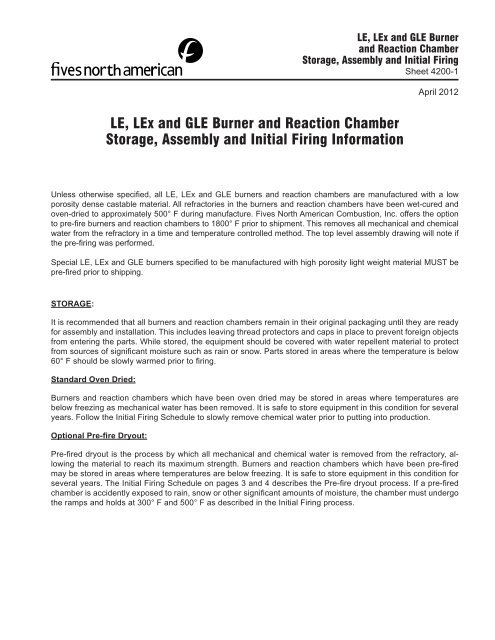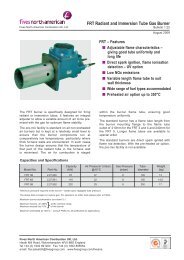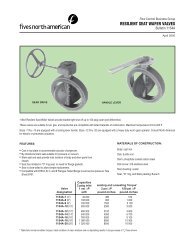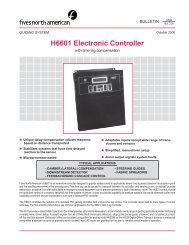LE, LEx and GLE Burner and Reaction Chamber - Fives North ...
LE, LEx and GLE Burner and Reaction Chamber - Fives North ...
LE, LEx and GLE Burner and Reaction Chamber - Fives North ...
Create successful ePaper yourself
Turn your PDF publications into a flip-book with our unique Google optimized e-Paper software.
STORAGE:<br />
It is recommended that all burners <strong>and</strong> reaction chambers remain in their original packaging until they are ready<br />
for assembly <strong>and</strong> installation. This includes leaving thread protectors <strong>and</strong> caps in place to prevent foreign objects<br />
from entering the parts. While stored, the equipment should be covered with water repellent material to protect<br />
from sources of signifi cant moisture such as rain or snow. Parts stored in areas where the temperature is below<br />
60° F should be slowly warmed prior to fi ring.<br />
St<strong>and</strong>ard Oven Dried:<br />
<strong>Burner</strong>s <strong>and</strong> reaction chambers which have been oven dried may be stored in areas where temperatures are<br />
below freezing as mechanical water has been removed. It is safe to store equipment in this condition for several<br />
years. Follow the Initial Firing Schedule to slowly remove chemical water prior to putting into production.<br />
Optional Pre-fi re Dryout:<br />
<strong>LE</strong>, <strong>LE</strong>x <strong>and</strong> G<strong>LE</strong> <strong>Burner</strong><br />
<strong>and</strong> <strong>Reaction</strong> <strong>Chamber</strong><br />
Storage, Assembly <strong>and</strong> Initial Firing<br />
Sheet 4200-1<br />
<strong>LE</strong>, <strong>LE</strong>x <strong>and</strong> G<strong>LE</strong> <strong>Burner</strong> <strong>and</strong> <strong>Reaction</strong> <strong>Chamber</strong><br />
Storage, Assembly <strong>and</strong> Initial Firing Information<br />
April 2012<br />
Unless otherwise specifi ed, all <strong>LE</strong>, <strong>LE</strong>x <strong>and</strong> G<strong>LE</strong> burners <strong>and</strong> reaction chambers are manufactured with a low<br />
porosity dense castable material. All refractories in the burners <strong>and</strong> reaction chambers have been wet-cured <strong>and</strong><br />
oven-dried to approximately 500° F during manufacture. <strong>Fives</strong> <strong>North</strong> American Combustion, Inc. offers the option<br />
to pre-fi re burners <strong>and</strong> reaction chambers to 1800° F prior to shipment. This removes all mechanical <strong>and</strong> chemical<br />
water from the refractory in a time <strong>and</strong> temperature controlled method. The top level assembly drawing will note if<br />
the pre-fi ring was performed.<br />
Special <strong>LE</strong>, <strong>LE</strong>x <strong>and</strong> G<strong>LE</strong> burners specifi ed to be manufactured with high porosity light weight material MUST be<br />
pre-fi red prior to shipping.<br />
Pre-fi red dryout is the process by which all mechanical <strong>and</strong> chemical water is removed from the refractory, allowing<br />
the material to reach its maximum strength. <strong>Burner</strong>s <strong>and</strong> reaction chambers which have been pre-fi red<br />
may be stored in areas where temperatures are below freezing. It is safe to store equipment in this condition for<br />
several years. The Initial Firing Schedule on pages 3 <strong>and</strong> 4 describes the Pre-fi re dryout process. If a pre-fi red<br />
chamber is accidently exposed to rain, snow or other signifi cant amounts of moisture, the chamber must undergo<br />
the ramps <strong>and</strong> holds at 300° F <strong>and</strong> 500° F as described in the Initial Firing process.
ASSEMBLY:<br />
CAUTION: PRIOR TO ASSEMBLY, ENSURE THAT ALL HOISTS AND ACCESSORIES ARE RATED FOR<br />
DUTY SUFFICIENT TO COMP<strong>LE</strong>TE REQUIRED WORK.<br />
<strong>Reaction</strong> chambers can be supplied either as one piece or as two piece assemblies including forward <strong>and</strong> rear sections.<br />
For installation of one piece reaction chambers, proceed to step 8 after unpacking.<br />
1. Remove debris <strong>and</strong> any packing material that is not required for storage. Air <strong>and</strong> gas inlets should remain<br />
covered until interconnect piping is installed to prevent foreign material from entering the burner. Hard-<br />
ware <strong>and</strong> gasket materials may be found inside the burner combustion air inlet for assemblies that were<br />
not assembled prior to shipment. Compare materials found to parts identifi ed on the assembly drawings to<br />
ensure you have all required parts.<br />
2. Inspect mating fl anges <strong>and</strong> other mounting areas on burner <strong>and</strong> reaction chamber interface sections.<br />
3. If your assembly includes a two piece reaction chamber, move the Forward <strong>Reaction</strong> <strong>Chamber</strong> (outlet)<br />
section to a cradle or other suitable assembly fi xture using appropriate lifting methods. For vertical assem-<br />
bly, the section can be positioned outlet down on a smooth, dry <strong>and</strong> level surface. The outlet should be<br />
protected from dirt <strong>and</strong> moisture. Often a yellow “x” is painted at what will be the 12:00 location (as in-<br />
stalled) on both chamber sections <strong>and</strong> the burner body to indicate the designed alignment.<br />
4. Install seal ring, rope gasket, drop warp or bolt hole tape at locations specifi ed on the reaction chamber<br />
assembly drawing. Be sure the sealing or insulating material is installed in such a manner as to prevent<br />
a leak path for hot gases. If sealing ring (fi ber) gaskets are supplied in sections, pre-fi t the sections by<br />
laying pieces end to end prior to adhering to the refractory. The sections should be the same<br />
width <strong>and</strong> form a complete circle. Refer to the assembly drawing section view to determine the correct<br />
surface for the gasket. Measure the outside <strong>and</strong> inside diameters <strong>and</strong> compare to what is listed on the<br />
assembly drawing. Trimming of the fi ber will not be required. Tape may be used to hold pieces together<br />
while locating the ring concentrically to refractory diameter. Spray adhesive or a small bead of high tem-<br />
perature RTV should be used to adhere the fi ber to the refractory or fl ange face. If Gortex tape is sup-<br />
plied, tape should be applied to a clean fl ange surface at a smaller diameter than the bolts in an area<br />
which will be in contact with the mating fl ange. Overlap the ends to prevent leakage. If bolt hole tape or<br />
similar material is supplied, use adhesive to hold material such that it covers the bolt holes. Use an awl or<br />
ball-peen hammer to make openings in the material.<br />
5. Consult appropriate assembly drawing to determine proper alignment of saddle pads, locator pins or any<br />
other attachment <strong>and</strong> support mechanisms. Look for a yellow “x” to ensure proper alignment of the<br />
sections.<br />
6. Using appropriate lifting methods, place the rear section reaction chamber in the proper location as illus-<br />
trated on the assembly drawing.<br />
7. Apply thread lubricant to bolt or stud threads. Use washers <strong>and</strong> nuts as specifi ed on the reaction chamber<br />
assembly drawing. Be sure the entire reaction chamber assembly is adequately supported prior to<br />
removing lifting mechanism.<br />
8. Sealing material such as bolt hole tape, Gortex or high temperature silicone (RTV) is required between<br />
the reaction chamber mounting plate <strong>and</strong> customer equipment. This material as well as fasteners may<br />
not be included with the equipment. Prepare customer equipment or reaction chamber mounting fl ange<br />
with proper sealing material prior to lifting the reaction chamber.<br />
9. If desired, the burner may be assembled to the reaction chamber prior to mounting the reaction chamber<br />
to customer's equipment. This is not recommended for larger or two-piece reaction chambers.<br />
10. Using appropriate lifting methods move <strong>and</strong> install the reaction chamber assembly in its permanent<br />
mounting location. Use thread lubricant, nuts <strong>and</strong> appropriate methodology to secure the reaction<br />
chamber.<br />
4200-1 Page 2
11. Install seal ring, rope gasket or bolt hole tape as specifi ed on the burner <strong>and</strong> reaction chamber assembly<br />
drawing. See Item #4 for tips on proper installation.<br />
12. Consult appropriate assembly drawing to determine proper orientation of saddle pads, locator pins or<br />
any other attachment <strong>and</strong> support mechanisms. Look for a yellow “x” to ensure proper alignment of the<br />
sections.<br />
13. After securing the reaction chamber, lift <strong>and</strong> place burner assembly in the proper location as illustrated on<br />
the assembly drawing.<br />
14. Apply thread lubricant to bolt or stud threads. Use washers <strong>and</strong> nuts as specifi ed on the burner <strong>and</strong><br />
reaction chamber assembly drawing. Be sure the entire assembly is adequately supported prior to remov-<br />
ing the lifting mechanism.<br />
15. All piping must be clean <strong>and</strong> free of debris prior to connecting to burner.<br />
16. Follow instructions for proper piping installation <strong>and</strong> control wiring.<br />
17. If no permanent temperature measuring equipment is installed, temporary instrumentation is recommend-<br />
ed for dryout.<br />
INITIAL FIRING INFORMATION:<br />
Measuring the reaction chamber refractory temperature is recommended during the initial fi ring of the system <strong>and</strong><br />
for subsequent cold restarts if feasible. It is recommended that a bare wire thermocouple junction be placed on the<br />
refractory surface near the reaction chamber exit. The exposed thermocouple junction should be covered with a<br />
small piece of insulating blanket to shield it from direct fl ame. The insulation must be weighted to remain in place<br />
during fi ring. Alternately, a removable thermocouple may be inserted through a sample port near the exit of the<br />
reaction chamber. The probe should be long enough to measure the temperature of the combustion products hot<br />
mix at the chamber exit. If the temperature of the inside surface of the refractory or the hot mix near the discharge<br />
of the reaction chamber cannot be measured, a defi ned procedure including excess air rates <strong>and</strong> length of time is<br />
required for at least the fi rst heat up. The Combustion Hot Mix method may be used when fl ame lengths will exceed<br />
the length of the reaction chamber. This includes <strong>LE</strong> <strong>and</strong> G<strong>LE</strong> assemblies, or <strong>LE</strong>x burners having st<strong>and</strong>ard or short<br />
reaction chambers.<br />
A chamber that has been fi red, either by the optional factory pre-fi ring or having been in service, <strong>and</strong> has not been<br />
exposed to signifi cant moisture should follow the “Cold Restart” instructions below. If a pre-fi red assembly has been<br />
exposed to signifi cant moisture before or after installation, or during maintenance, follow the instructions for ramp<br />
<strong>and</strong> hold at 300° F <strong>and</strong> 500° F described in the Initial Firing process. When in doubt, the slow ramp <strong>and</strong> hold process<br />
should be followed.<br />
Using Combustion Hot Mix Temperatures as an alternative to Measurement of Hot Face Temperature<br />
The excess air values <strong>and</strong> corresponding hot mix temperatures listed below are based on 120° F combustion air<br />
<strong>and</strong> Natural Gas. These can be used for prefi ring the burner <strong>and</strong> reaction chamber as recommended where: the<br />
excess air measured is for burner air <strong>and</strong> fuel only (no process air); <strong>and</strong> if the combustion system air <strong>and</strong> fuel fl ow<br />
measurement instrumentation’s correct function <strong>and</strong> accuracy has been verifi ed. Obtaining hot mix temperatures<br />
below 600° F may require operation with pilot only. Values not listed as “hold” temperatures are included for reference<br />
to assist with ramp rates.reference to assist with ramp rates.<br />
Percent Excess Air Approximate Hot Mix Temperature<br />
2750% 300º F<br />
1230% 500º F<br />
750% 700º F<br />
510% 900º F<br />
325% 1200º F<br />
225% 1500º F<br />
160% 1800º F<br />
130% 2000º F<br />
4200-1 Page 3
Initial Firing<br />
Note: If at any time during the fi ring cycle “steaming” is observed, hold the temperature constant until the<br />
“steaming” dissipates, then resume the remaining schedule beginning from the time the “steaming” hold<br />
began.<br />
1. Begin the dryout by lighting the burner pilot <strong>and</strong> increasing pilot gas fl ow as needed for the desired refrac-<br />
tory or hot mix temperature. If “glowing” of the pilot or its connection boss occurs during fi ring, a small fan<br />
or other air supply directed upon the hot area should be used to keep the pilot cool during extended op-<br />
eration. As temperature requirements increase, light the radial burner to increase the input.<br />
2. If temporary thermocouples cannot be installed in the reaction chamber refractory or at its exit, the pro-<br />
cess or other system temperatures may be used (with appropriate allowances for temperature losses) to<br />
infer the reaction chamber refractory temperatures. As an alternate, the burner hot mix temperature may<br />
be predicted by the overall fuel to air ratio as described previously. Remember, it is the temperature inside<br />
the reaction chamber that needs to be maintained, not an overall process temperature.<br />
3. The following time <strong>and</strong> temperature schedule is recommended :<br />
3 hour ramp from 60° F to 300° F<br />
6 hour soak at 300° F<br />
3 hour ramp from 300° F to 500° F<br />
6 hour soak at 500° F<br />
9 hour ramp to 1200° F (75° F per hour)<br />
6 hour soak at 1200° F 1<br />
8 hour ramp to 1800° F (75° F per hour)<br />
6 hour soak at 1800° F<br />
X hour ramp to operating temperature (100° F per hour) 2<br />
12 hour (minimum) cooling period from maximum temperature to ambient at a maximum of 150° F per hour<br />
unless starting production<br />
1 This soak period may be eliminated when the application does not require cyclic operation or when prefi ring<br />
will not exceed 2000° F.<br />
2 No soak period required. Note that typical <strong>LE</strong>x, <strong>LE</strong> <strong>and</strong> G<strong>LE</strong> applications are expected to operate with hot<br />
mix temperatures lower than 2800° F <strong>and</strong> the lean fuel-to-air ratio required to achieve the design maximum<br />
hot mix temperature is intended to be an operating limit for the particular system. Only exceed 2600° F<br />
after consultation with <strong>Fives</strong> <strong>North</strong> American on the specifi c operational settings for the system. In no case<br />
exceed 2800° F for St<strong>and</strong>ard Dense Castable or 3000° F for High Temperature, Low Cement Castable as<br />
damage to both burner internals <strong>and</strong> refractories may result.<br />
NOTE: Pre-fi ring refractory results in permanent linear change to the material. Cracking in both longitudinal<br />
<strong>and</strong> circumferential directions up to 3/16" wide may be observed after the chamber is cooled. When the<br />
chamber is reheated during operation, the refractory will exp<strong>and</strong>, decreasing the width of these cracks.<br />
Rapid heat <strong>and</strong> cool cycles will increase cracking <strong>and</strong> decrease the life expectancy of the refractory.<br />
Initial Firing after Optional Pre-fi re Dryout or Cold Restart<br />
Cold restart is defi ned as starting the burner system when the reaction chamber refractory is below 1000° F. The<br />
refractory is assumed to be 60° to 90° F prior to lighting.<br />
1. Light the burner <strong>and</strong> hold at low fi re.<br />
2. Increase burner fi ring rate such that the reaction chamber refractory will reach 400° F in one (1) hour. For<br />
chambers below 60° F, ramp to 400° F at a rate of 100° F per hour.<br />
3. Increase temperature set point by 300° to 400° F per hour until process temperature is achieved.<br />
WARNING: Situations dangerous to personnel <strong>and</strong> property may exist with the operation <strong>and</strong> maintenance of any combustion equipment. The presence of fuels, oxidants, hot <strong>and</strong> cold<br />
combustion products, hot surfaces, electrical power in control <strong>and</strong> ignition circuits, etc., are inherent with any combustion application. Parts of this product may exceed 160F in operation <strong>and</strong><br />
present a contact hazard. <strong>Fives</strong> <strong>North</strong> American Combustion, Inc. urges compliance with National Safety St<strong>and</strong>ards <strong>and</strong> Insurance Underwriters recommendations, <strong>and</strong> care in operation.<br />
<strong>Fives</strong> <strong>North</strong> American Combustion, Inc. - 4455 East 71st Street - Clevel<strong>and</strong>, OH 44105 USA - Phone 216.271.6000<br />
Fax 216.641.7852 - email: fna.sales@fi vesgroup.com - www.fi vesgroup.com/fi vesna<br />
Page 4<br />
4-12-4200-1







